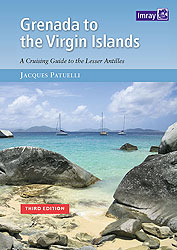| |
|

Coastline and anchorages
The beauty of the coast and sailing from
island to island in armchair comfort (the
biggest distance is no more than some 7
miles) can make you lazy and even make
you forget your navigational skills.
However, you should always be alert
because there are many coral reefs, the
passes are tricky and the currents are
often strong. The regular current runs
from W to WNW. However, the tidal
current runs E. It isn’t a fast set, but it
can raise a lively sea in the channels.
Don’t sail at night because the lights are
unreliable. Given how crowded some of
the anchorages are, including the
prettiest ones, you have to hunt a bit for
a quiet spot. Such places are usually
surrounded by reefs and therefore
require a careful approach in good
visibility, avoiding having the sun ahead.
Before leaving for the Grenadines you
need to know the following:

|
|
|
|
• fishing and spear fishing are regulated
and mostly forbidden to non-residents.
There are protected underwater zones
•watering ship is not possible in all the
islands and water is always expensive
• fuel docks are equally sparse and you
must plan ahead thoroughly
• apart from Bequia, and to a lesser extent
Union and Carriacou, repair and
maintenance services are not to be relied
on
•provisioning at many of the islands
depends on the shops there and the
reliability (or lack of) of their supplies
• any boat that is wrecked swiftly becomes
public property to the benefit of certain
local ‘specialists’
•petty theft from onboard can be an issue
in certain anchorages, fortunately there
are few such spots.
However, once you’re alert to these
potential bothers, provided you take
sensible precautions and exercise a
minimum of vigilance, you can enjoy
peaceful sailing in this micro-paradise for
sailors.
|
|
|







